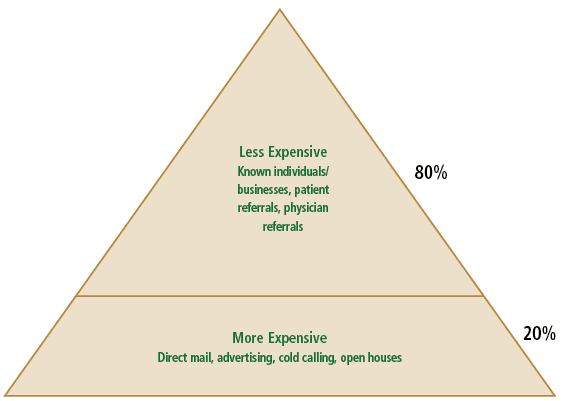Marketing | November 2014 Hearing Review
Knowing your marketing ROI is critical. Here’s how to do it.
By Scott Berger, MBA, and Lindsey Brennan-Pierangeli
Effective marketing requires establishing benchmarks for successful efforts, collecting the data generated by your marketing tactics, and measuring their success or lack thereof through ROI analysis. Ultimately, ROI analysis provides you with the knowledge and ability to adjust your marketing plan to capture beneficial trends or eliminate wasteful spending.
Two of the most important components for the financial success of your practice are an effective marketing plan and an analysis of its financial results or ROI. Quickly and simply, ROI is a measurement of your return on investment. We are getting ahead of ourselves, however; we will discuss ROI in detail a bit later.
For now, what is important to keep in mind is your marketing efforts may appear to be cohesive and effective, but a practice owner/manager really does not know how effective they are without analyzing the numbers. And that is achieved only through proper tracking.
Marketing Pyramid
Before doing ROI calculations and analyses, you, the owner/manager, have to ensure that your marketing programs are planned effectively. To start the planning, we at American Hearing Aid Associates (AHAA) promote the Marketing Pyramid to our network members (Figure 1).

[Click on figure to enlarge.] Figure 1. The Marketing Pyramid. It makes the most sense to concentrate most of your marketing (eg, about 80% of your focus) on easier-to-achieve, less expensive marketing efforts. However, it is the 20% that can make all the difference and is absolutely critical to measure and benchmark ROI.
The media used to connect with your targets may be similar, but the message and frequency will vary considerably. Consider community events as an example; they may be used for developing new prospects or introducing existing customers to current technology. Both are marketing activities, but the first is designed to add patients to the practice database (prospects) while the second creates growth from the existing database (current customers).
Marketing Plan Strategy
The first step in creating a prospect marketing plan is to establish a budget, ideally around 10-12% of projected gross sales. Next, you must identify your opportunity and referral sources, then define the appropriate target audiences for each. Finally, you select the media you will use to reach them and allocate expenditures to each.
For example, you may want to put 50% of your budget into direct mail, 40% into newspapers, and 10% into online vehicles. Each situation is different, but this proportion is a safe starting point for most practices looking to start a plan.
Next, identify benchmarks for estimated response rates. For example:
- Direct Mail .25 to 1% calls per mailing (ie, 12-50 calls per 5,000 pieces mailed)
- Newspaper Inserts 10 calls +/- per ~ 30,000 distribution
- Newspaper Ads 1-5 calls per ad (with a call-to-action feature)
In looking at any of these vehicles, you must match your target audiences to the proper media. For direct mail, for example, you would pull out a list of top performing zip codes from your patient database, then cross reference with a territorial analysis (x-mile radius, patient demographics, competitors) if you have access to that information. This establishes your target criteria.
Then reach out to direct mail list vendors to determine the total residents in your target area who match your criteria. Buy the names identified, and use direct mail tactics to create frequency, making sure to mail to the target pool on a consistent basis.
Collecting the Data
When the results come in, someone in your practice must keep track of them. Many computer programs are available that facilitate and simplify tracking (AHAA has one), but typically a person(s) in your office must physically input the response data.
Response tracking must be done because it is from this data that you will determine your ROI for the marketing program and, therefore, its success or lack thereof. So appoint the person(s) who will be responsible for tracking, and actively manage them as they work on this important task.
Quarterly Reviews
Every marketing plan must be periodically reviewed. We advocate quarterly reviews to assess progress, performance against the plan, and to ensure that expenditures are being allocated effectively. Monthly reviews do not show trends. Annual reviews result in missed opportunities by not adjusting plans frequently enough to invest more in well-performing efforts or prevent leaking cash on underperforming activities. This approach is similar to financial investment strategies and portfolio management.
In the reviews, analyze results from all media used and determine when and how you need to make adjustments. You can now calculate your ROI—which we explain in more detail below—but be sure to look closely at the raw response data too. Response tells you how well you attracted attention (making the phone ring); ROI tells you how well you did as a result of that attention (profitability of the effort). Response is a grade of your marketing and the media, ROI is a grade of the processes and interactions that follow those efforts.
A new marketing plan should run for at least one quarter before making any changes. Be sure to take advantage of well performing activities with follow-up initiatives or complementary activities. In other words, adapt your marketing to your results and the trends. Prolong positive performing activities and reduce poorly performing activities.
When Good Marketing Plans Go Bad
The best plans can go bad for a number of reasons. One is that they are not executed or continued for at least a quarter as advocated at the start. Another is that your office staff is not properly prepared for the marketing event. That is, they must anticipate the responses, be trained how to receive those calls, and properly book appointments. They must be aware of selling techniques for different marketing events and how to follow up on some campaigns.
As a business leader, you must recognize what is working well and what is not working well within your operation, planning to emphasize the former and adjusting or ceasing the latter. You should continually train and monitor your staff by listening to recorded calls related to your marketing tracking activities.
Enter ROI
As part of your marketing plan, you will identify how each project will be measured to budget, to accomplishments, and to your end goal. Your data collection efforts—which are critical and must be done properly—will identify where your prospects are coming from. This leads to calculating ROI as you compare response rates and sales to their associated costs to arrive at the effectiveness of the marketing tactics.
Overall ROI provides an indication of profitability relative to total expenditure. Practically speaking, calculating your ROI will tell you how well you are using your practice’s resources to generate profit. To calculate ROI, the benefit (return) of an investment is divided by the cost of the investment; the result is expressed as a percentage or a ratio.
Any effort or specific project your practice does can be calculated in terms of ROI to measure its success or sustainability. Using the outreach advertising expenses we cited as an example, here is a general overview of elements that would typically be used to measure ROI for a direct mail campaign for one office location:
- Direct mail package and number of pieces mailed. Count every direct mail package used in the quarter. For each package, calculate the number of unique mailings and the number of pieces mailed for each within the quarter.
- Total cost. Enter cost of all direct mail expenses, including mailing list purchases, printing, envelopes, postage, and labor (staff and outside services) for each unique package mailed.
- Average cost of each direct mail package. Total expenses divided by number of unique mailings.
- Total and average number of calls received for each direct mail package. Capture the numbers.
- Actual vs expected response rate. Capture the numbers. Using call tracking tools, record all qualified responses to the offer (eliminating calls requesting to be removed from future mailings or general information calls). As mentioned earlier, one benchmark estimate for direct mail response may be .25 to 1% calls per mailing, or about 12-50 calls per 5,000 pieces mailed. If you do not have a benchmark, you can ask your direct mail partner, make a conservative estimate based on your best guess, or hire a consultant to guide you.
- Total and average number of appointments from direct mail vehicles. Capture the numbers. This information lets you calculate the percentage of responses that become appointments.
- The total and average number of units sold from direct mail vehicles. Capture the numbers. This information lets you calculate the percentage of responses that become actual sales. To truly calculate ROI, you will need to know (or be able to estimate) your actual sales from any specific effort. Additionally, you will want to calculate your practice’s average close rate—the average percentage of appointments that results in hearing aids sold.
After all of the data are entered and manipulated, you should be able to see how many units were sold, the gross and net revenue from the sales, the cost per call (response cost), the cost per appointment (conversion cost), the cost per units sold (total cost of each sale), the total number of calls and appointments, the cost of the direct mailing, the cost of goods sold, and the resulting ROI.
When you invest money in any marketing effort, you should look critically at the sales generated, the associated expenses, and ROI generated. If the revenue generated exceeded the amount spent, it is considered a favorable ROI and a positive business development activity. Only you can decide if the amount of the excess is sufficient to keep driving your practice forward in a meaningful way.
We cannot presume to make you an ROI expert in one article. As we said earlier, we recommend you utilize a computer program to allow easy recording of data and confer with industry experts to help in producing the calculations you need.
Conclusion
It’s vital to create an effective marketing plan, with its accompanying tactics, and actively manage it in real time. This is facilitated by establishing benchmarks for identifying successful efforts, collecting the data generated by your tactics, and measuring their success or lack thereof through ROI analysis. Ultimately, ROI analysis provides you with the knowledge and ability to adjust your plan to capture beneficial trends or eliminate wasteful spending.
Acknowledgement
This article is based on a presentation made at the AHAA 2014 annual convention held in Grapevine, Tex.
CORRESPONDENCE can be addressed to Scott Berger at: [email protected] or Lindsey Brennan-Pierangeli at: [email protected]






